Xingxing Wei
Beijing Key Laboratory of Digital Media, School of Computer Science and Engineering, Beihang University, Beijing, China
RGBT-Ground Benchmark: Visual Grounding Beyond RGB in Complex Real-World Scenarios
Dec 31, 2025Abstract:Visual Grounding (VG) aims to localize specific objects in an image according to natural language expressions, serving as a fundamental task in vision-language understanding. However, existing VG benchmarks are mostly derived from datasets collected under clean environments, such as COCO, where scene diversity is limited. Consequently, they fail to reflect the complexity of real-world conditions, such as changes in illumination, weather, etc., that are critical to evaluating model robustness and generalization in safety-critical applications. To address these limitations, we present RGBT-Ground, the first large-scale visual grounding benchmark built for complex real-world scenarios. It consists of spatially aligned RGB and Thermal infrared (TIR) image pairs with high-quality referring expressions, corresponding object bounding boxes, and fine-grained annotations at the scene, environment, and object levels. This benchmark enables comprehensive evaluation and facilitates the study of robust grounding under diverse and challenging conditions. Furthermore, we establish a unified visual grounding framework that supports both uni-modal (RGB or TIR) and multi-modal (RGB-TIR) visual inputs. Based on it, we propose RGBT-VGNet, a simple yet effective baseline for fusing complementary visual modalities to achieve robust grounding. We conduct extensive adaptations to the existing methods on RGBT-Ground. Experimental results show that our proposed RGBT-VGNet significantly outperforms these adapted methods, particularly in nighttime and long-distance scenarios. All resources will be publicly released to promote future research on robust visual grounding in complex real-world environments.
From reactive to cognitive: brain-inspired spatial intelligence for embodied agents
Aug 24, 2025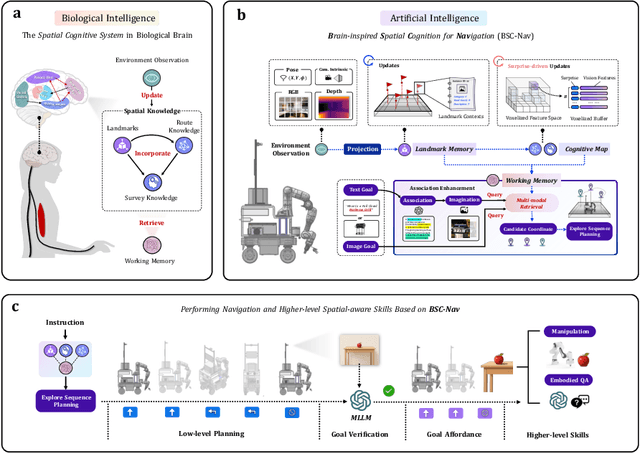
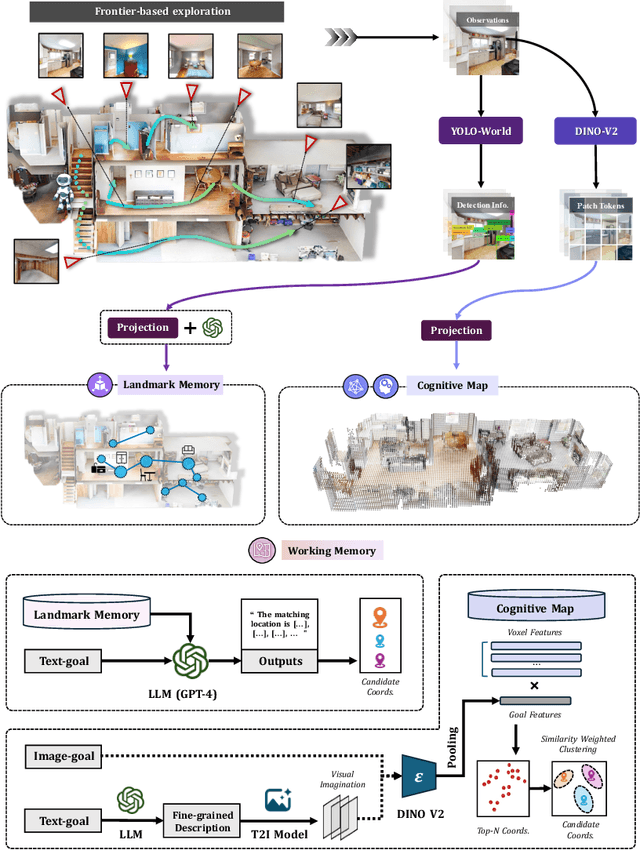
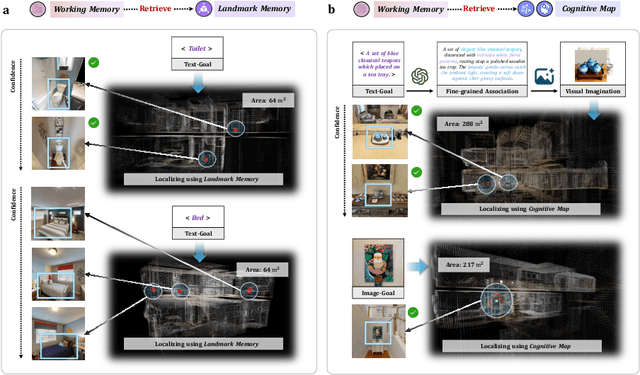
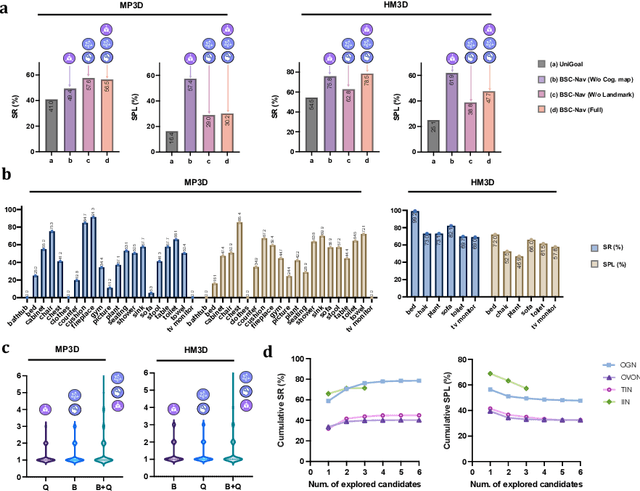
Abstract:Spatial cognition enables adaptive goal-directed behavior by constructing internal models of space. Robust biological systems consolidate spatial knowledge into three interconnected forms: \textit{landmarks} for salient cues, \textit{route knowledge} for movement trajectories, and \textit{survey knowledge} for map-like representations. While recent advances in multi-modal large language models (MLLMs) have enabled visual-language reasoning in embodied agents, these efforts lack structured spatial memory and instead operate reactively, limiting their generalization and adaptability in complex real-world environments. Here we present Brain-inspired Spatial Cognition for Navigation (BSC-Nav), a unified framework for constructing and leveraging structured spatial memory in embodied agents. BSC-Nav builds allocentric cognitive maps from egocentric trajectories and contextual cues, and dynamically retrieves spatial knowledge aligned with semantic goals. Integrated with powerful MLLMs, BSC-Nav achieves state-of-the-art efficacy and efficiency across diverse navigation tasks, demonstrates strong zero-shot generalization, and supports versatile embodied behaviors in the real physical world, offering a scalable and biologically grounded path toward general-purpose spatial intelligence.
NS-FPN: Improving Infrared Small Target Detection and Segmentation from Noise Suppression Perspective
Aug 09, 2025Abstract:Infrared small target detection and segmentation (IRSTDS) is a critical yet challenging task in defense and civilian applications, owing to the dim, shapeless appearance of targets and severe background clutter. Recent CNN-based methods have achieved promising target perception results, but they only focus on enhancing feature representation to offset the impact of noise, which results in the increased false alarms problem. In this paper, through analyzing the problem from the frequency domain, we pioneer in improving performance from noise suppression perspective and propose a novel noise-suppression feature pyramid network (NS-FPN), which integrates a low-frequency guided feature purification (LFP) module and a spiral-aware feature sampling (SFS) module into the original FPN structure. The LFP module suppresses the noise features by purifying high-frequency components to achieve feature enhancement devoid of noise interference, while the SFS module further adopts spiral sampling to fuse target-relevant features in feature fusion process. Our NS-FPN is designed to be lightweight yet effective and can be easily plugged into existing IRSTDS frameworks. Extensive experiments on the public IRSTDS datasets demonstrate that our method significantly reduces false alarms and achieves superior performance on IRSTDS tasks.
Towards Class-wise Fair Adversarial Training via Anti-Bias Soft Label Distillation
Jun 10, 2025Abstract:Adversarial Training (AT) is widely recognized as an effective approach to enhance the adversarial robustness of Deep Neural Networks. As a variant of AT, Adversarial Robustness Distillation (ARD) has shown outstanding performance in enhancing the robustness of small models. However, both AT and ARD face robust fairness issue: these models tend to display strong adversarial robustness against some classes (easy classes) while demonstrating weak adversarial robustness against others (hard classes). This paper explores the underlying factors of this problem and points out the smoothness degree of soft labels for different classes significantly impacts the robust fairness from both empirical observation and theoretical analysis. Based on the above exploration, we propose Anti-Bias Soft Label Distillation (ABSLD) within the Knowledge Distillation framework to enhance the adversarial robust fairness. Specifically, ABSLD adaptively reduces the student's error risk gap between different classes, which is accomplished by adjusting the class-wise smoothness degree of teacher's soft labels during the training process, and the adjustment is managed by assigning varying temperatures to different classes. Additionally, as a label-based approach, ABSLD is highly adaptable and can be integrated with the sample-based methods. Extensive experiments demonstrate ABSLD outperforms state-of-the-art methods on the comprehensive performance of robustness and fairness.
Breaking the Ceiling: Exploring the Potential of Jailbreak Attacks through Expanding Strategy Space
May 28, 2025Abstract:Large Language Models (LLMs), despite advanced general capabilities, still suffer from numerous safety risks, especially jailbreak attacks that bypass safety protocols. Understanding these vulnerabilities through black-box jailbreak attacks, which better reflect real-world scenarios, offers critical insights into model robustness. While existing methods have shown improvements through various prompt engineering techniques, their success remains limited against safety-aligned models, overlooking a more fundamental problem: the effectiveness is inherently bounded by the predefined strategy spaces. However, expanding this space presents significant challenges in both systematically capturing essential attack patterns and efficiently navigating the increased complexity. To better explore the potential of expanding the strategy space, we address these challenges through a novel framework that decomposes jailbreak strategies into essential components based on the Elaboration Likelihood Model (ELM) theory and develops genetic-based optimization with intention evaluation mechanisms. To be striking, our experiments reveal unprecedented jailbreak capabilities by expanding the strategy space: we achieve over 90% success rate on Claude-3.5 where prior methods completely fail, while demonstrating strong cross-model transferability and surpassing specialized safeguard models in evaluation accuracy. The code is open-sourced at: https://github.com/Aries-iai/CL-GSO.
Mitigating Overthinking in Large Reasoning Models via Manifold Steering
May 28, 2025Abstract:Recent advances in Large Reasoning Models (LRMs) have demonstrated remarkable capabilities in solving complex tasks such as mathematics and coding. However, these models frequently exhibit a phenomenon known as overthinking during inference, characterized by excessive validation loops and redundant deliberation, leading to substantial computational overheads. In this paper, we aim to mitigate overthinking by investigating the underlying mechanisms from the perspective of mechanistic interpretability. We first showcase that the tendency of overthinking can be effectively captured by a single direction in the model's activation space and the issue can be eased by intervening the activations along this direction. However, this efficacy soon reaches a plateau and even deteriorates as the intervention strength increases. We therefore systematically explore the activation space and find that the overthinking phenomenon is actually tied to a low-dimensional manifold, which indicates that the limited effect stems from the noises introduced by the high-dimensional steering direction. Based on this insight, we propose Manifold Steering, a novel approach that elegantly projects the steering direction onto the low-dimensional activation manifold given the theoretical approximation of the interference noise. Extensive experiments on DeepSeek-R1 distilled models validate that our method reduces output tokens by up to 71% while maintaining and even improving the accuracy on several mathematical benchmarks. Our method also exhibits robust cross-domain transferability, delivering consistent token reduction performance in code generation and knowledge-based QA tasks. Code is available at: https://github.com/Aries-iai/Manifold_Steering.
Enhancing Adversarial Robustness of Vision Language Models via Adversarial Mixture Prompt Tuning
May 23, 2025Abstract:Large pre-trained Vision Language Models (VLMs) have excellent generalization capabilities but are highly susceptible to adversarial examples, presenting potential security risks. To improve the robustness of VLMs against adversarial examples, adversarial prompt tuning methods are proposed to align the text feature with the adversarial image feature without changing model parameters. However, when facing various adversarial attacks, a single learnable text prompt has insufficient generalization to align well with all adversarial image features, which finally leads to the overfitting phenomenon. To address the above challenge, in this paper, we empirically find that increasing the number of learned prompts can bring more robustness improvement than a longer prompt. Then we propose an adversarial tuning method named Adversarial Mixture Prompt Tuning (AMPT) to enhance the generalization towards various adversarial attacks for VLMs. AMPT aims to learn mixture text prompts to obtain more robust text features. To further enhance the adaptability, we propose a conditional weight router based on the input adversarial image to predict the mixture weights of multiple learned prompts, which helps obtain sample-specific aggregated text features aligning with different adversarial image features. A series of experiments show that our method can achieve better adversarial robustness than state-of-the-art methods on 11 datasets under different experimental settings.
Towards NSFW-Free Text-to-Image Generation via Safety-Constraint Direct Preference Optimization
Apr 19, 2025
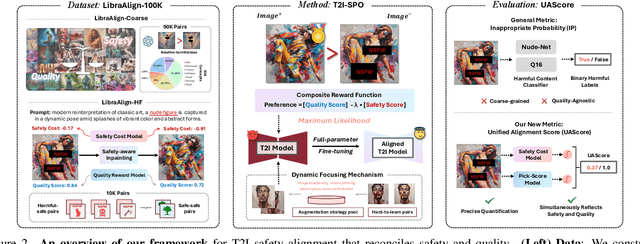

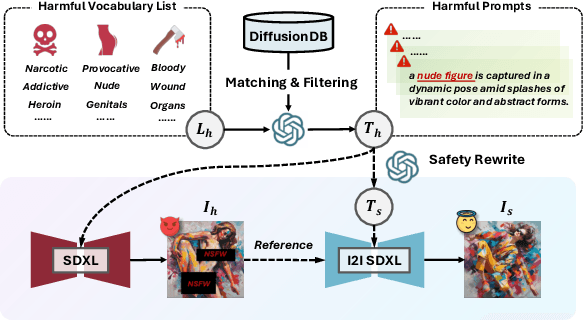
Abstract:Ensuring the safety of generated content remains a fundamental challenge for Text-to-Image (T2I) generation. Existing studies either fail to guarantee complete safety under potentially harmful concepts or struggle to balance safety with generation quality. To address these issues, we propose Safety-Constrained Direct Preference Optimization (SC-DPO), a novel framework for safety alignment in T2I models. SC-DPO integrates safety constraints into the general human preference calibration, aiming to maximize the likelihood of generating human-preferred samples while minimizing the safety cost of the generated outputs. In SC-DPO, we introduce a safety cost model to accurately quantify harmful levels for images, and train it effectively using the proposed contrastive learning and cost anchoring objectives. To apply SC-DPO for effective T2I safety alignment, we constructed SCP-10K, a safety-constrained preference dataset containing rich harmful concepts, which blends safety-constrained preference pairs under both harmful and clean instructions, further mitigating the trade-off between safety and sample quality. Additionally, we propose a Dynamic Focusing Mechanism (DFM) for SC-DPO, promoting the model's learning of difficult preference pair samples. Extensive experiments demonstrate that SC-DPO outperforms existing methods, effectively defending against various NSFW content while maintaining optimal sample quality and human preference alignment. Additionally, SC-DPO exhibits resilience against adversarial prompts designed to generate harmful content.
Rethinking Multi-modal Object Detection from the Perspective of Mono-Modality Feature Learning
Mar 14, 2025Abstract:Multi-Modal Object Detection (MMOD), due to its stronger adaptability to various complex environments, has been widely applied in various applications. Extensive research is dedicated to the RGB-IR object detection, primarily focusing on how to integrate complementary features from RGB-IR modalities. However, they neglect the mono-modality insufficient learning problem that the decreased feature extraction capability in multi-modal joint learning. This leads to an unreasonable but prevalent phenomenon--Fusion Degradation, which hinders the performance improvement of the MMOD model. Motivated by this, in this paper, we introduce linear probing evaluation to the multi-modal detectors and rethink the multi-modal object detection task from the mono-modality learning perspective. Therefore, we construct an novel framework called M$^2$D-LIF, which consists of the Mono-Modality Distillation (M$^2$D) method and the Local Illumination-aware Fusion (LIF) module. The M$^2$D-LIF framework facilitates the sufficient learning of mono-modality during multi-modal joint training and explores a lightweight yet effective feature fusion manner to achieve superior object detection performance. Extensive experiments conducted on three MMOD datasets demonstrate that our M$^2$D-LIF effectively mitigates the Fusion Degradation phenomenon and outperforms the previous SOTA detectors.
When Lighting Deceives: Exposing Vision-Language Models' Illumination Vulnerability Through Illumination Transformation Attack
Mar 10, 2025



Abstract:Vision-Language Models (VLMs) have achieved remarkable success in various tasks, yet their robustness to real-world illumination variations remains largely unexplored. To bridge this gap, we propose \textbf{I}llumination \textbf{T}ransformation \textbf{A}ttack (\textbf{ITA}), the first framework to systematically assess VLMs' robustness against illumination changes. However, there still exist two key challenges: (1) how to model global illumination with fine-grained control to achieve diverse lighting conditions and (2) how to ensure adversarial effectiveness while maintaining naturalness. To address the first challenge, we innovatively decompose global illumination into multiple parameterized point light sources based on the illumination rendering equation. This design enables us to model more diverse lighting variations that previous methods could not capture. Then, by integrating these parameterized lighting variations with physics-based lighting reconstruction techniques, we could precisely render such light interactions in the original scenes, finally meeting the goal of fine-grained lighting control. For the second challenge, by controlling illumination through the lighting reconstrution model's latent space rather than direct pixel manipulation, we inherently preserve physical lighting priors. Furthermore, to prevent potential reconstruction artifacts, we design additional perceptual constraints for maintaining visual consistency with original images and diversity constraints for avoiding light source convergence. Extensive experiments demonstrate that our ITA could significantly reduce the performance of advanced VLMs, e.g., LLaVA-1.6, while possessing competitive naturalness, exposing VLMS' critical illuminiation vulnerabilities.
 Add to Chrome
Add to Chrome Add to Firefox
Add to Firefox Add to Edge
Add to Edge